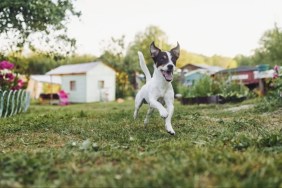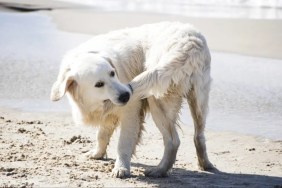A single chewing mistake can be extremely expensive. I think the Canine Chewing World Record belongs to a Manhattan Malamute which destroyed over $15,000 worth of furniture and fittings in less than three hours! The cost of chewtoys is minimal compared with the potential cost of misdirected chewing. Consequently, when away from home, leave your pup in its long-term confinement area with a good supply of chewtoys. Not only will this precaution confine any possible chewing activity to that area, but also it will help redirect the puppy’s chewing proclivities to appropriate chewtoys, since these are the only chewable objects at hand.
A chewtoy is an item which the dog may chew but cannot destroy or consume. If your dog destroys chewtoys, you will have to pay to replace them. If your dog consumes chewtoys, sooner or later you will be faced with a medical emergency and a large veterinary bill. Use only non-destructible, non-consumable chewtoys. The specific type will depend on your dog.
Which ever type you chose, though, please remember your dog cannot read the label and instructions on the package and so you must actively teach your pup what chewtoys are for. Play chewtoy games: “Take chewtoy,” “Fetch chewtoy” and “Find chewtoy.” It is a good plan to have a toy box in a permanently accessible location, so your pup knows where it can always find a toy should it be in need of a quick chew. Above all, praise and reward your pup whenever it plays with one of its toys.
Inappropriate chewing is seldom an issue when the owner is home; it is almost exclusively an owner-absent problem (created by the owner), which primarily occurs immediately after the owner has left in the morning and immediately before the owner returns in the afternoon/evening. Dogs are crepuscular and are normally most active at dawn and dusk. Most dogs dare not chew whilst the owner is at home, and so in the mornings it eagerly awaits the owner’s departure to indulge its chewing habit. (Much like a person looking forward to the spouse’s morning departure in anticipation of the first illegal cigarette of the day.) In the afternoons, the dog chews partly as its activity level increases and partly to quell the stress created by the prospect of punishment upon the owner’s return. Ensuring that your pup is engrossed with a chewtoy, both at the time of your departure and prior to your return, goes a long way to preventing owner-absent house destruction.
When leaving
Before departing in the morning, give your pup a novel chewtoy. The novelty, and hence the value, of the chewtoy may be enhanced in a number of ways. Rawhide toys may be soaked in different flavored soups. Let them dry and voila! – a different flavored chewtoy for each morning of the week. Alternatively, tasty treats may be squished into the marrow cavity of a large (indestructible), open-ended knuckle bone or Kong chewtoy. Sterilized bones and Kongs are available from most pet shops. Stuff the chewtoys so some treats fall out fairly easily as your dog chews, but other treats never come out, prompting your dog to continue to work at the chewtoy.
Make sure to leave your pup in its long-term confinement area, littered with stuffed chewtoys. This is like leaving a child and a television in an empty room. The child will watch the box and become a TV addict. Similarly, the pup will chew the chewtoys (since there is precious else to do) and develop a chewtoy habit, because chewing novel and attractive chewtoys quickly becomes self-reinforcing. This process is a form of passive training , whereby all you have to do is set up the situation, and the dog all but trains itself to become a chewtoyaholic.
When returning
On returning home, the best reward is yourself, and so delay greeting your pup until it fetches a chewtoy. Within a few days, you will be greeted at the front door by your puppy doing an impersonation of a retriever with a dumbbell. Thus, when your pup wakes up and becomes re-energized in the afternoon, it will search for a chewtoy in anticipation of the forthcoming attention and affection upon your return. The ritual is facilitated if you take the proffered chewtoy, extricate the squished treats (with a pencil) and give them to the pup.
When at home, always try to reinforce your puppy’s chewtoy habit with further passive training. Confine your pup to its crate, tie-down, or place, with the only object in reach being a chewtoy stuffed with all sorts of goodies. This is so important with young puppies during their first few days at home, since they quickly become fixated on the first few objects they chew and play with.
Once your pup knows what it should be chewing, it is time to let it know what it should not be chewing. Every time the pup even sniffs a likely alternative, the instructive reprimand “Chewtoy!” will quickly set the puppy straight. The tone and volume inform the pup it is about to make a booboo, and the meaning of the word instructs the pup what it should be chewing. In addition, it is a good idea to boobytrap prime chewing targets.
Boobytraps
A well-designed boobytrap has a number of significant attributes. Firstly, boobytraps are effective at times when owners are absent. Secondly, the dog is punished by the boobytrap and not by its owner. Thus, the dog may be effectively punished without risking the danger of ruining the relationship between owner and dog. Boobytraps are extremely effective because of the immediacy and relevancy of the punishment. A good boobytrap startles the dog the moment it transgresses. The dog is punished by the environment. The dog investigates the environment, and the environment is unfriendly. It is similar to a dog putting its nose into a candle flame – it only does it once. With boobytraps, learning is often a one-trial process.
The types of boobytrap may be many and varied and are limited only by the imagination and ingenuity of the owner/designer. My favorite designs all incorporate numerous empty beer cans. The same basic principle may be applied to protect a variety of objects – armchairs, carpets, children’s toys, food on the table, and garbage cans. Twenty or so beer cans (each containing a couple of pebbles for maximum rattle-effect) are stacked on a sheet of cardboard, which is placed on top of three other cans, one of which is balanced on the edge of a shelf or counter, overhanging the object to be protected, e.g., the kitchen garbage. A piece of string links the precariously balanced support-can to the bait, e.g., a piece of paper dipped in chicken broth or bacon fat, which is laid on top of crumpled newspaper which fills the garbage can. When the dog grabs the bait, the string tugs out one of the bottom three beer cans, causing the cardboard to tilt and all the other beer cans to crash around the dog.
Since we do not want to live in a house which is permanently boobytrapped, set up the booby trap but do not connect the trip wire. Give the dog time to get used to the presence of the boobytrap. Otherwise, the dog will make the connection between the booby trap and the falling cans, i.e., it will stay away from the garbage when the cans are present, but trash the garbage when you have dismantled the booby trap.
The effectiveness of any boobytrap is improved with the addition of a warning cue. Immediately prior to arming the booby trap, wipe the garbage container with a novel odor, e.g., a new lemon-scented cleaner or perfume, or any odorous substance the dog has never previously encountered. Since the dog has trashed successfully many times before, but this time the world dropped on its head, it will no doubt surmise “Ahhh! The smell. That’s what’s different.” The dog quickly makes the connection between the novel odor and the falling beer cans. Now, the olfactory warning cue – the new cleaner – may be applied to other objects where the dog’s nose is not desired, such as counter tops, chair legs, the cat’s litter box and the underside of carpets. The odor warns the dog: touch this and beer cans are likely to drop on your head, so the dog doesn’t touch. The effectiveness of avoidance conditioning lies with the warning cue; the warning cue deters the dog from touching the protected item, and so at a later date, it never learns the boobytrap is no longer armed.
Excerpted from How to Teach An Old Dog New Tricks, by Ian Dunbar.
Ian Dunbar is a veterinarian and animal behaviorist, founder of the Association of Pet Dog Trainers, and the author and star of numerous books and videos on dog behavior and training. He lives in Berkeley, California with his wife, trainer Kelly Dunbar, and their three dogs. The Dunbars are contributing editors to DogTime.









